Throughout history, blue birds have been symbols of hope and happiness, as well as the subjects of art, poetry, songs and mythology. The color blue has long been associated with tranquility and calmness, and watching blue birds outside our windows warms our hearts, makes us smile, and brightens up our winter afternoons.
But did you know that not all blue birds are Bluebirds? There are several species of blue-feathered birds that you can attract to your feeders, depending on where you live.
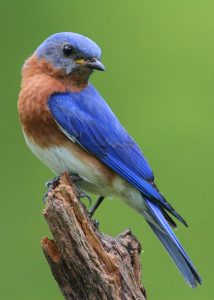 Of course, Bluebirds are the best known. America is home to three varieties. Mountain Bluebird males are azure all over, whereas Eastern and Western Bluebirds have a contrasting russet-colored chest and white belly; the quickest way to tell these similar varieties apart is by location. Eastern Bluebirds are found east of the Rocky Mountains, and are the state bird of New York. Mountain Bluebirds and Western Bluebirds are found in the west. These vibrant beauties love insects, so mealworms are the best way to attract them to your yard. If you have the space, hang up a nest box and watch them feed their babies in the spring!
Of course, Bluebirds are the best known. America is home to three varieties. Mountain Bluebird males are azure all over, whereas Eastern and Western Bluebirds have a contrasting russet-colored chest and white belly; the quickest way to tell these similar varieties apart is by location. Eastern Bluebirds are found east of the Rocky Mountains, and are the state bird of New York. Mountain Bluebirds and Western Bluebirds are found in the west. These vibrant beauties love insects, so mealworms are the best way to attract them to your yard. If you have the space, hang up a nest box and watch them feed their babies in the spring!
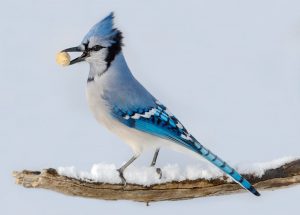 Blue Jays are gregarious social birds, known for their blue and white plumage, raucous calls, and often-hilarious antics. Attract these large expressive birds with a platform feeder of mixed seed, which you can top with a sprinkle of whole peanuts for an extra treat. Blue Jays are frequent feeder visitors east of the Rockies.
Blue Jays are gregarious social birds, known for their blue and white plumage, raucous calls, and often-hilarious antics. Attract these large expressive birds with a platform feeder of mixed seed, which you can top with a sprinkle of whole peanuts for an extra treat. Blue Jays are frequent feeder visitors east of the Rockies.
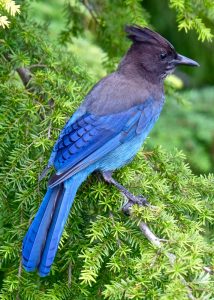 Do you want to be entertained for hours? Steller’s Jays with their blue feathers and charcoal gray heads are a favorite at our West Coast feeders. There’s a reason why a group of jays is called “a scold of jays”: animated and inquisitive, they are superb mimics, imitating other birds, squirrels, cats, babies and even mechanical objects! Steller’s Jays (named after the German naturalist Georg Wilhelm Steller, the first European to record their existence) are easily attracted to your feeders with black oil sunflower seeds. You’ll want to use a platform feeder to give these social birds enough space in case they arrive with friends.
Do you want to be entertained for hours? Steller’s Jays with their blue feathers and charcoal gray heads are a favorite at our West Coast feeders. There’s a reason why a group of jays is called “a scold of jays”: animated and inquisitive, they are superb mimics, imitating other birds, squirrels, cats, babies and even mechanical objects! Steller’s Jays (named after the German naturalist Georg Wilhelm Steller, the first European to record their existence) are easily attracted to your feeders with black oil sunflower seeds. You’ll want to use a platform feeder to give these social birds enough space in case they arrive with friends.
 Indigo Buntings are small perching birds with cerulean feathers that are nearly iridescent. Fill your tube feeders with thistle seed, which Indigo Buntings will happily share with Goldfinches, and your yard could play host to one of the most colorful shows in nature. They prefer brushy areas on the edges of forests and are found east of the Rockies and sporadically through the Southwest.
Indigo Buntings are small perching birds with cerulean feathers that are nearly iridescent. Fill your tube feeders with thistle seed, which Indigo Buntings will happily share with Goldfinches, and your yard could play host to one of the most colorful shows in nature. They prefer brushy areas on the edges of forests and are found east of the Rockies and sporadically through the Southwest.
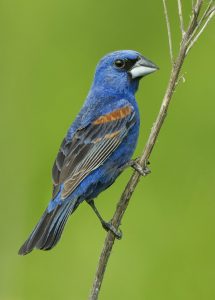 Occupying the southern half of the US from coast to coast, Blue Grosbeaks are gorgeous and unique-looking birds with beaks that appear to cover their whole faces. Often heard before they’re seen: they have lovely warbling calls and a distinctive side-to-side tail wag. You can invite these cobalt birds to your feeders with mixed seed or fresh fruit.
Occupying the southern half of the US from coast to coast, Blue Grosbeaks are gorgeous and unique-looking birds with beaks that appear to cover their whole faces. Often heard before they’re seen: they have lovely warbling calls and a distinctive side-to-side tail wag. You can invite these cobalt birds to your feeders with mixed seed or fresh fruit.
One fascinating fact? Blue birds’ color is an optical illusion! What we perceive as blue is actually the light reflecting off air pockets inside their feathers. It’s called “structural color” instead of pigmented color.
Do you have any blue friends visiting your feeders? We’d love to hear all about it in the comments.

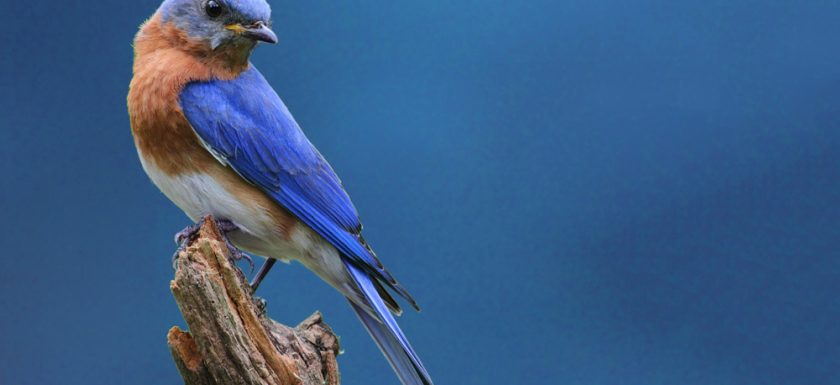
Yes we have the Blue Bird with the rust and white chest, Blue Jays, Indigo Bunting and Blue Grosbeak. They are beautiful and so fun.
Do you have any suggestions of getting rid of squirrels? They are multiplying and digging holes and damaging my feeders. Thank you!
Hi Charmin!
Sorry to hear about your squirrel troubles! You can keep squirrels out of your bird feeders by using poles instead of trees to hang feeders. Place the poles at least 6 feet away from any branches the squirrels might jump from, and use baffles to prevent them from climbing the poles themselves. (If you’re the crafty type, try this easy DIY baffle: http://bit.ly/2ssRA8L) You can also mix cayenne powder into your seeds when you fill the feeder – birds aren’t bothered by spicy foods, but squirrels can’t stand the heat. Lastly, keep the ground under the feeder clear of any seeds that have fallen. Try putting a catch bucket under the feeder to make cleaning easier!
It sounds like your squirrels are a problem beyond just your feeders, though. Too many squirrels in a neighborhood can become a danger to pets & kids, so you may want to reach out to your local animal control department and make them aware of the issue.